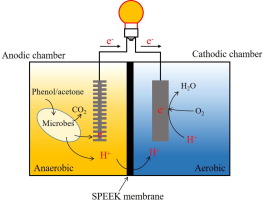当前位置:
X-MOL 学术
›
Bioresource Technol.
›
论文详情
Our official English website, www.x-mol.net, welcomes your
feedback! (Note: you will need to create a separate account there.)
Electricity generation and removal performance of a microbial fuel cell using sulfonated poly (ether ether ketone) as proton exchange membrane to treat phenol/acetone wastewater
Bioresource Technology ( IF 9.7 ) Pub Date : 2018-04-03 , DOI: 10.1016/j.biortech.2018.03.133 Hao Wu , Yu Fu , Chunyu Guo , Yanbo Li , Nanzhe Jiang , Chengri Yin
Bioresource Technology ( IF 9.7 ) Pub Date : 2018-04-03 , DOI: 10.1016/j.biortech.2018.03.133 Hao Wu , Yu Fu , Chunyu Guo , Yanbo Li , Nanzhe Jiang , Chengri Yin

|
The microbial fuel cell (MFC) has emerged as a promising technology for wastewater treatment and energy recovery, but the expensive cost of proton exchange membranes (PEMs) is a problem that need to be solved. In this study, a two-chamber MFC based on our self-made PEM sulfonated poly (ether ether ketone) membrane was set up to treat phenol/acetone wastewater and synchronously generate power. The maximum output voltage was 240–250 mV. Using phenol and acetone as substrates, the power generation time in an operation cycle was 289 h. The MFC exhibited good removal performance, with no phenol or acetone detected, respectively, when the phenol concentration was lower than 50 mg/L and the acetone concentration was lower than 100 mg/L. This study provides a cheap and eco-friendly way to treat phenol/acetone wastewater and generate useful energy by MFC technology.
中文翻译:

以磺化聚醚醚酮为质子交换膜的微生物燃料电池处理苯酚/丙酮废水的发电及除电性能
微生物燃料电池(MFC)已成为一种有前景的废水处理和能源回收技术,但质子交换膜(PEM)昂贵的成本是一个需要解决的问题。本研究搭建了基于我们自制的PEM磺化聚醚醚酮膜的两室MFC,用于处理苯酚/丙酮废水并同步发电。最大输出电压为 240–250 mV。以苯酚和丙酮为底物,一个运行周期的发电时间为289 h。 MFC表现出良好的去除性能,当苯酚浓度低于50 mg/L和丙酮浓度低于100 mg/L时,分别未检测到苯酚和丙酮。这项研究提供了一种廉价且环保的方法来处理苯酚/丙酮废水并通过MFC技术产生有用的能源。
更新日期:2018-04-03
中文翻译:

以磺化聚醚醚酮为质子交换膜的微生物燃料电池处理苯酚/丙酮废水的发电及除电性能
微生物燃料电池(MFC)已成为一种有前景的废水处理和能源回收技术,但质子交换膜(PEM)昂贵的成本是一个需要解决的问题。本研究搭建了基于我们自制的PEM磺化聚醚醚酮膜的两室MFC,用于处理苯酚/丙酮废水并同步发电。最大输出电压为 240–250 mV。以苯酚和丙酮为底物,一个运行周期的发电时间为289 h。 MFC表现出良好的去除性能,当苯酚浓度低于50 mg/L和丙酮浓度低于100 mg/L时,分别未检测到苯酚和丙酮。这项研究提供了一种廉价且环保的方法来处理苯酚/丙酮废水并通过MFC技术产生有用的能源。











































 京公网安备 11010802027423号
京公网安备 11010802027423号